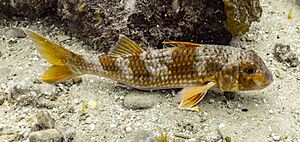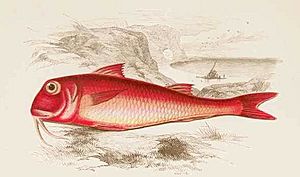Red mullet facts for kids
Quick facts for kids Red mullet |
|
|---|---|
 |
|
| Conservation status | |
| Scientific classification | |
| Synonyms | |
|
The Red Mullet (scientific name: Mullus barbatus) is a cool type of goatfish that lives in the Mediterranean Sea, the Black Sea, and parts of the North Atlantic Ocean. You can find them from places like Scandinavia all the way down to Senegal. People often catch them for food, especially by trawling, because their meat is considered very tasty! Good news for these fish: experts say they are currently a "least concern" when it comes to their numbers in the wild.
Contents
About Its Name
This fish got its scientific name, Mullus barbatus, way back in 1758. It was named by a famous Swedish scientist named Carl Linnaeus. He was the one who created the system we use today to name all living things!
There are actually two main types, or subspecies, of Red Mullet:
- Mullus barbatus barbatus: This is the most common type, found in most places where Red Mullets live.
- Mullus barbatus ponticus: This type is mostly found in the Black Sea and the Sea of Azov.
What They Look Like
Red Mullets can grow to be about 30 centimeters (around 12 inches) long, but most of them are usually half that size. Their bodies are a bit flat on the sides. They have a short, steep snout, and no sharp spines on their gill covers.
One interesting thing about them is their mouth! They don't have teeth on their upper jaw, but they do have teeth on the roof of their mouth and on their lower jaw. They also have two long, whisker-like feelers called barbels under their chin. These barbels are super important for finding food!
Their first top fin has eight spines, and the second top fin has one spine and eight soft rays. These fish are a pretty rose-pink color all over, and their fins don't have any special markings.
Where They Live and What They Like
You can find Red Mullets in the Mediterranean Sea, the Black Sea, and the northeastern and central eastern Atlantic Ocean. Their home stretches from Scandinavia down to Senegal, including islands like the Canary Islands, Azores, and Madeira.
They are demersal fish, which means they live near the bottom of the sea. They like to hang out in depths from about 10 to 328 meters (around 33 to 1,076 feet). They prefer soft bottoms made of mud, sand, or gravel.
What They Eat and Who Eats Them
Red Mullets are carnivores, which means they eat other animals. Their favorite foods include:
- Polychaete worms (a type of sea worm)
- Bivalve molluscs (like clams and mussels)
- Crustaceans (like small crabs and shrimp)
Remember those barbels under their chin? They're like super-sensitive feelers! Red Mullets use them to search for and find their prey hidden in the sand or mud.
Many other fish like to eat Red Mullets, both young and old. Some of their predators include:
- The angler fish
- The thornback ray
- The common stingray
- The school shark
- The John Dory
- The European hake
Life Cycle and Reproduction
Red Mullets usually breed in the spring and summer months. In places like the Adriatic Sea, they lay their eggs in April and May, at depths of about 60 to 70 meters (around 197 to 230 feet).
When the baby Red Mullets (larvae) hatch, they are pelagic, meaning they float around in the open water. As they grow a bit bigger, they move closer to the coast. Once they are about 5 centimeters (2 inches) long, they become demersal and start living on the seabed, often gathering in river mouths or estuaries. Sometimes, they even swim a short distance up rivers!
Later, they spread out to muddy, sandy, or gravelly areas. They become ready to have their own babies when they are about 10 to 14 centimeters (4 to 5.5 inches) long, usually during their first year of life.
Conservation Status
Red Mullets are very popular for eating, especially in the Mediterranean Sea, Black Sea, and parts of the Atlantic Ocean. They are mostly caught using large fishing nets called trawls. They are also caught with other nets, hooks, and even spears by smaller fishing boats.
In some areas, like the Mediterranean, there are signs that too many Red Mullets are being caught. Many of the fish caught are smaller than 15 centimeters (6 inches), which means they are less than two years old and haven't had a chance to reproduce yet. To help protect them, it's important to keep their breeding and nursery areas safe.
Even though they are heavily fished, the International Union for Conservation of Nature (IUCN) currently lists the Red Mullet as a "least concern" species. This is because they live in a wide range of places, can be found in deep waters, and are even expanding their range northwards as ocean temperatures rise.



